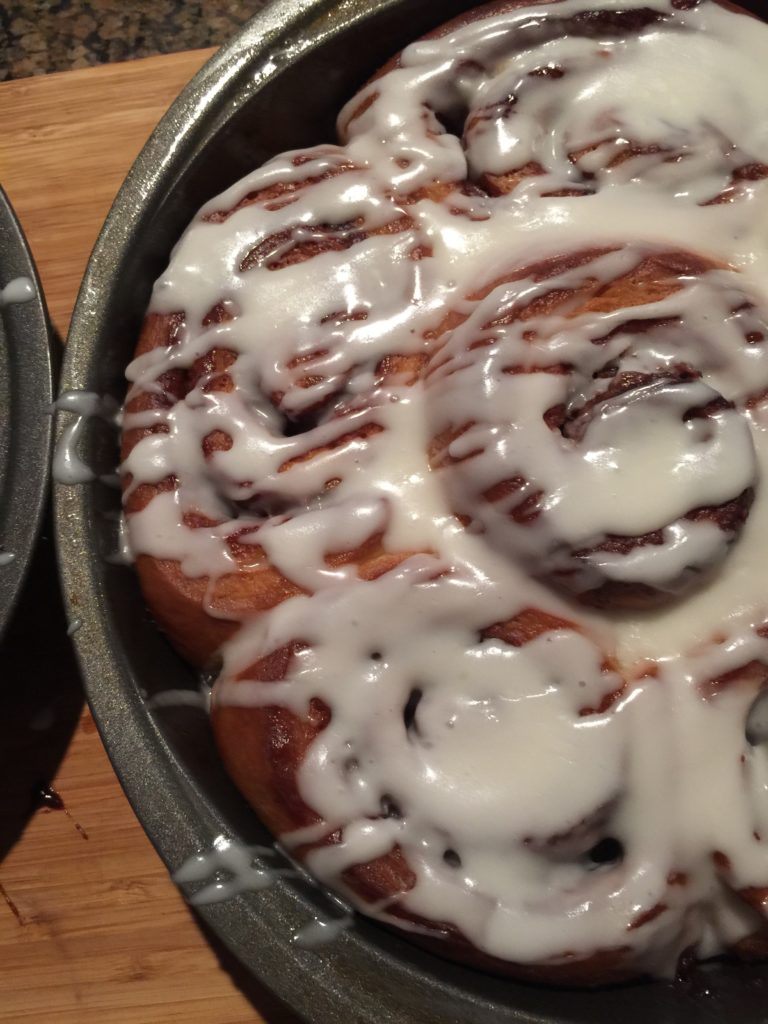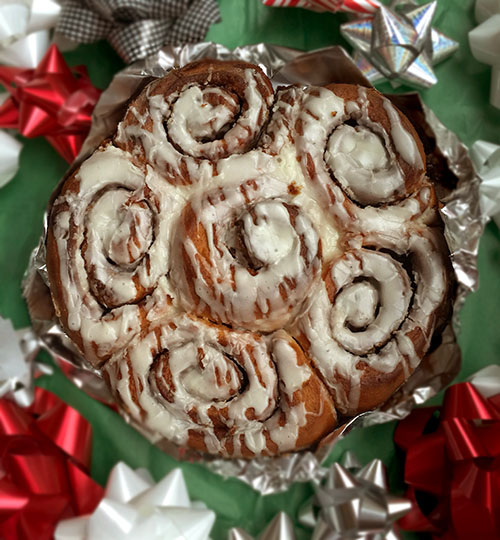 [T]he first food gift I remember was wrapped in aluminum foil and topped with an adhesive-backed bow. Cinnamon rolls…jillions of them, all over the countertops in their silver packets, awaiting Christmastime delivery to family, friends, neighbors.
[T]he first food gift I remember was wrapped in aluminum foil and topped with an adhesive-backed bow. Cinnamon rolls…jillions of them, all over the countertops in their silver packets, awaiting Christmastime delivery to family, friends, neighbors.
My mom got up in the wee hours of the morning to do this, because the rolls were made in small batches — many, many small batches of her favorite simple bread dough recipe she let rise once , then shaped into the long rolls of dough filled with butter, white sugar and cinnamon and sliced into enticing swirls. She baked them in every pan in every size she had. There were clusters of these sweet buns in round cake tins, 13-by-9 glass dishes, square and loaf pans. She’d pull them out of the oven and gingerly tip them out to see if their bottoms were browned adequately, and if so, take a stick of butter or margarine and rub the top of each panful, letting the bread’s heat soak up an extra buttery sheen.
She then glazed them simply, while still warm. Then after some cooling, wrapped them up and distributed them over the course of a day or two. And everyone LOVED them. She claims now that she doesn’t know where she got her pep. Knowing more about bread-making now than I did then, I don’t know, either. At the time, it all seemed so simple and easy, dozens of cinnamon rolls. But I know better.
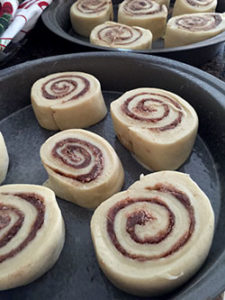 I’ve been wanting to make cinnamon rolls all year, and even years before, for a Christmastime bread for “A Woman Sconed.†I do actually do some planning with this blog, and my “list†of forecasted breads for the last seven years has always included cinnamon rolls in honor of the woman who taught me to bake and taught me to give baking. Why I’ve only gotten to it now I’m not sure. I’ve been distracted away by other prospects maybe. Or I’ve been saving this one ’til now…for some reason.
I’ve been wanting to make cinnamon rolls all year, and even years before, for a Christmastime bread for “A Woman Sconed.†I do actually do some planning with this blog, and my “list†of forecasted breads for the last seven years has always included cinnamon rolls in honor of the woman who taught me to bake and taught me to give baking. Why I’ve only gotten to it now I’m not sure. I’ve been distracted away by other prospects maybe. Or I’ve been saving this one ’til now…for some reason.
[M]y cinnamon roll-baking came after about a month or more of nonstop baking/cooking projects, deadlines, endless exhaustion at my job, and cobbled together Christmas stuff — presents, decorating, etc.
It wasn’t in me to make another thing, I’m sad to say. I’ve been feeling this lately, and it worries me. That perhaps AWS is burned out on the making, or she’s just burned out. She’s getting old, too, she tells herself, and perhaps she is dwindling in the drive — both physically and mentally — to keep doing this.
 Still, there is something to it that keeps her at it. The work materializes even when it feels there is nothing more than a mere shadow producing it. Over the last year, the word “faith†keeps coming up. Because, despite everything and because of everything, there was and is always a belief in THIS, whatever it is. When everything seemed gone or going or lost, THIS still materialized, which means there is something to us that goes beyond the obvious, if that makes sense
Still, there is something to it that keeps her at it. The work materializes even when it feels there is nothing more than a mere shadow producing it. Over the last year, the word “faith†keeps coming up. Because, despite everything and because of everything, there was and is always a belief in THIS, whatever it is. When everything seemed gone or going or lost, THIS still materialized, which means there is something to us that goes beyond the obvious, if that makes sense
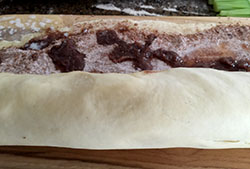 I gathered more than ingredients to make a batch of holiday cinnamon rolls. I gathered who my mother was, and who I was as the young girl, watching. I gathered what was left of me and the year I’d been through and the one bread I’d wanted to make as a gift. To myself. Yes, Sometimes we must do THAT.
I gathered more than ingredients to make a batch of holiday cinnamon rolls. I gathered who my mother was, and who I was as the young girl, watching. I gathered what was left of me and the year I’d been through and the one bread I’d wanted to make as a gift. To myself. Yes, Sometimes we must do THAT.
I don’t know where my mom got her pep to make dozens of cinnamon rolls, but as I let my single batch of dough come together and rise, I knew making bread really made me happy, or, at least, soothed my troubles. Like nothing else. When your dough rises like it should, you start to believe in everything else than can be.
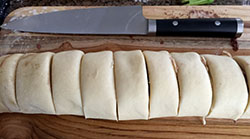 [I] blended my mother’s recipe with a new one I discovered, and mixed her filling of straight granulated sugar (with LOTS of cinnamon) with one that was all brown sugar (I ended up with mostly white and a little brown).
[I] blended my mother’s recipe with a new one I discovered, and mixed her filling of straight granulated sugar (with LOTS of cinnamon) with one that was all brown sugar (I ended up with mostly white and a little brown).
I rolled the dough round its filling, tightly as I could, the smooth, fleshy dough cooperating (and there is gratitude in that, as well as all the steps leading to THAT, like active yeast, proper kneading, proper rising, proper attitude).
 I took a moment to christen a new chef’s knife and cut the long roll into segments for the individual rolls, then laid out the firm spirals in two round cake pans. They looked even and concise, these swirls, and I knew they had all they needed to become what they would be.
I took a moment to christen a new chef’s knife and cut the long roll into segments for the individual rolls, then laid out the firm spirals in two round cake pans. They looked even and concise, these swirls, and I knew they had all they needed to become what they would be.
Here, I took a chance, another faith of sorts, and put the un-raised rolls in the fridge overnight to bake in the morning, which my “recipe†assured would work. If my mother had been so advised or she had so trusted, I wonder if it would have helped, to not herself rise in the wee hours to begin the whole process from scratch. Still, she had to do it her way, finding comfort in her own process. And she did have the pep (and she still does). I raised my own rolls early the next morning, and their time in the fridge did not dissuade them from lift-off.
 [O]nce I felt sure baking was complete (yes, I tipped the pan to make sure their bottoms were browned), I took a stick of butter — and my mother’s hand — to the rolls, hot and golden brown from their baking, and gave them an initial shiny veneer.
[O]nce I felt sure baking was complete (yes, I tipped the pan to make sure their bottoms were browned), I took a stick of butter — and my mother’s hand — to the rolls, hot and golden brown from their baking, and gave them an initial shiny veneer.
I followed with a second coat of a simple confectioner’s sugar glaze (melted butter, powdered sugar, milk, vanilla, a pinch of salt). I kept a light hand with the glaze…my belief is that frostings and glazes are an accent, not to be overloaded, particularly for a bread.
I could have made more of these, many more, and run them all over town, like my mom did. Maybe sometime in the future, I will. This batch was for me. Sometimes you keep these things for yourself. And give in other ways…
Cinnamon Rolls
Adapted from The New York Times
Makes 9 to 12 rolls
Roll dough:
1 cup whole milk
4 tablespoons sugar
2-/14 teaspoons active dry yeast (1/4-ounce envelope)
3-1/2 cups all-purpose flour, plus more for dusting
1-1/2 teaspoons baking powder
1-1/4 teaspoons kosher salt
1 large egg, lightly beaten
6 tablespoons unsalted butter, melted
Nonstick spray or vegetable oil, for the bowl
Filling, glaze and assemble:
1 cup granulated sugar
1/4 cup light brown sugar
2 tablespoons ground cinnamon
1/2 teaspoon kosher salt
1/2 cup unsalted butter (1 stick), melted
3 cups confectioners’ sugar
2 tablespoons butter, melted
1/2 teaspoon vanilla extract
5 to 6 tablespoons whole milk or heavy cream
Make the dough: Warm milk in a small pot over medium heat until it’s warm to the touch but not yet simmering (110 degrees). Add 2 tablespoons sugar and the yeast, whisking to dissolve and break up any clumps. Let sit until it’s slightly foamy and starting to bubble, about 2 to 5 minutes. (If this doesn’t happen after about 5 minutes, check the expiration date on the yeast; it might be dead.)
Meanwhile, combine flour, the remaining 2 tablespoons sugar, the baking powder and the salt in a large bowl or in the bowl of a stand mixer fitted with the paddle attachment. Mix briefly to combine.
Add milk mixture, followed by the egg and, with a wooden spoon or the mixer on low, stir to combine, just to eliminate any obviously dry or wet spots. If using the mixer, you may need to scrape the dough off the paddle. Add melted butter and continue to stir until a shaggy lump of dough forms, again scraping down the paddle and helping things along with your hands if necessary to combine.
Turn dough out onto a lightly floured work surface, or keep in the mixing bowl and change to the dough hook attachment. Knead dough until it’s smooth, shiny and elastic, about 4 or 5 minutes. (You shouldn’t have to add any more flour at this point, but if the dough seems especially sticky, give it a light dusting.)
Lightly grease a large bowl with nonstick spray or vegetable oil and place dough in the bowl. Cover tightly with plastic wrap and place in a warm, draft-free area. (If it’s cold outside, on top of the stove is generally a good bet, as long as the burners and oven aren’t on.) Let sit until the dough has about doubled in size, 1 1/2 to 2 hours.
Punch dough down to release any air that has built up. Cover tightly with plastic wrap, place in the refrigerator and chill the dough for at least an hour (and as long as overnight).
Fill the dough and shape the rolls:Â Once dough is chilled (it should feel firm and no longer flimsy), turn it out onto a lightly floured work surface and roll to a 16 x 10-inch rectangle. The rolled dough will be about 1/4- to 1/3-inch thick.
Combine brown sugar, cinnamon and salt in a small bowl. Brush surface of the dough with half of the melted butter and sprinkle brown sugar mixture in an even layer, patting to make sure it’s sticking. Drizzle with remaining butter.
Starting at the end closest to you (the long side of the dough), roll dough up into a tight coil, pressing lightly as you roll to make sure there are no gaps between the dough and the filling.
Cut log into nine even pieces (or 12, for slightly smaller rolls), about 1 3/4-inch thick. Lightly spray a 9 x 13-inch baking dish or two 9-inch round cake pans with nonstick spray and arrange dough rolls with the spiral facing upward and with space in between each piece. (At this point, the rolls can be covered tightly with plastic wrap and refrigerated overnight, if you’d like.)Â
Cover rolls lightly with plastic wrap and place in a warm, draft-free area until the rolls have puffed (they won’t quite double, but they will be noticeably fluffier and closer to touching) and spring back slightly when pressed with your finger, about 1 hour. (If you refrigerated the rolls overnight, this may take 1 1/2 to 2 hours.)Â
Heat oven to 375 degrees. Place rolls in oven and bake until they are golden brown and fluffy and the sugar has started to bubble up around the edges, caramelizing on the sides of the buns, about 32 to 35 minutes.Â
Meanwhile, make the glaze: combine confectioners’ sugar, melted butter, vanilla and milk and whisk until it is thick but can still be drizzled, like a thinner frosting. (If the glaze is still too thick, thin with more milk by the
teaspoonful to get desired consistency.) Keep in mind the glaze is to be applied while buns are warm, and it will thin out upon contact, so it’s best to err on the thicker side.
Once rolls are out of the oven, drizzle with the powdered sugar glaze and let cool slightly in the pan before digging in.
Blogger’s Note: I baked these at 350 degrees for the designated
baking time.
